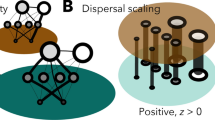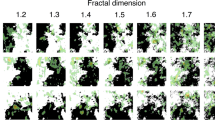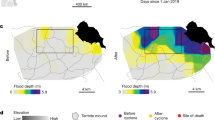Abstract
Scaling laws that describe complex interactions between organisms and their environment as a function of body size offer exciting potential for synthesis in biology1,2,3,4. Home range size, or the area used by individual organisms, is a critical ecological variable that integrates behaviour, physiology and population density and strongly depends on organism size5,6,7. Here we present a new model of home range–body size scaling based on fractal resource distributions, in which resource encounter rates are a function of body size. The model predicts no universally constant scaling exponent for home range, but defines a possible range of values set by geometric limits to resource density and distribution. The model unifies apparently conflicting earlier results and explains differences in scaling exponents among herbivorous and carnivorous mammals and birds5,6,7,8,9,10,11,12,13,14,15,16,17,18. We apply the model to predict that home range increases with habitat fragmentation, and that the home ranges of larger species should be much more sensitive to habitat fragmentation than those of smaller species.
This is a preview of subscription content, access via your institution
Access options
Subscribe to this journal
Receive 51 print issues and online access
$199.00 per year
only $3.90 per issue
Buy this article
- Purchase on Springer Link
- Instant access to full article PDF
Prices may be subject to local taxes which are calculated during checkout



Similar content being viewed by others
References
Milne, B. T. in Wildlife and Landscape Ecology: Effects of Pattern and Scale (ed. Bissonette, J. A.) 32–69 (Springer, New York, 1997)
Peters, R. H. The Ecological Implications of Body Size (Cambridge Univ. Press, New York, 1983)
Calder, W. A. Size, Function, and Life History (Dover, Mineola, New York, 1996)
West, G. B., Brown, J. H. & Enquist, B. J. A general model for the origin of allometric scaling laws in biology. Science 276, 122–126 (1997)
Damuth, J. Home range, home range overlap, and species energy use among herbivorous mammals. Biol. J. Linn. Soc. 15, 185–193 (1981)
Holling, C. S. Cross-scale morphology, geometry, and dynamics of ecosystems. Ecol. Monogr. 62, 447–502 (1992)
Reiss, M. Scaling of home range size: body size, metabolic needs and ecology. Trends Ecol. Evol. 3, 85–88 (1988)
Belovsky, G. E. in Viable Populations for Conservation (ed. Soule, M. E.) (Cambridge Univ. Press, Cambridge, 1987)
McNab, B. K. Bioenergetics and the determination of home range size. Am. Nat. 97, 133–140 (1963)
Swihart, R. K., Slade, N. A. & Bergstrom, B. J. Relating body size to the rate of home range use in mammals. Ecology 69, 393–399 (1988)
Whiting, L. The body mass allometries as evolutionarily determined by the foraging of mobile organisms. J. Theor. Biol. 177, 129–137 (1995)
Armstrong, J. T. Breeding home range in the nighthawk and other birds: its evolutionary and ecological significance. Ecology 46, 619–629 (1965)
Schoener, T. W. Sizes of feeding territories among birds. Ecology 49, 123–141 (1968)
Gompper, M. E. & Gittleman, J. L. Home range scaling: Intraspecific and comparative trends. Oecologia 87, 343–348 (1991)
Harestad, A. S. & Bunnell, F. L. Home range and body weight—A reevaluation. Ecology 60, 389–482 (1979)
Owen-Smith, R. N. Megaherbivores: The Influence of Very Large Body Size on Ecology (Cambridge Univ. Press, New York, 1992)
Lindstedt, S. L., Miller, B. J., Buskirk, S. W. Home range, time and body size in mammals. Ecology 67, 413–418 (1986)
Kelt, D. A. & VanVuren, D. Energetic constraints and the relationship between body size and home range area in mammals. Ecology 80, 337–340 (1999)
Lawton, J. H. Are there general laws in ecology? Oikos 84, 177–192 (1999)
Ritchie, M. E. Scale-dependent foraging and patch choice in fractal environments. Evol. Ecol. 12, 309–330 (1998)
Ritchie, M. E. & Olff, H. Spatial scaling laws yield a synthetic theory of biodiversity. Nature 400, 557–560 (2000)
Lawler, G., Schramm, O. & Werner, W. The dimension of the planar brownian frontier is 4/3. Math. Res. Lett. 8, 13–25 (2001)
Milne, B. T. Spatial aggregation and neutral models in fractal landscapes. Am. Nat. 139, 32–57 (1992)
Kunin, W. E. Extrapolating species abundance across spatial scales. Science 281, 1513–1515 (1998)
Mandelbrot, B. B. The Fractal Geometry of Nature (Freeman, New York, 1982)
Olff, H. & Ritchie, M. E. Fragmented nature: consequences for biodiversity. Landscape Urban Planning 858, 1–10 (2001)
Kotler, N. B. & Wiens, J. A. Multiple scales of patchiness and patch structure: a hierarchical framework for the study of heterogeneity. Oikos 59, 253–260 (1990)
Poole, A. & Gill, F. (eds) The Birds of North America (The Birds of North America, Philadelphia, 1996–2000)
Dunning, J. B. CRC Handbook of Avian Body Masses (CRC, Boca Raton, 1993)
Brown, J. H. in Experimental Ecology (eds Resetarits, W. J. Jr & Bernardo, J.) 71–95 (Oxford Univ. Press, New York, 1998)
Acknowledgements
We thank J. Brown, B. Enquist, J. Damuth and G. Belovsky. Work on this model began during the Fractals in Biology Meeting at the Santa Fe Institute, New Mexico. J.P.H. is supported by an NSF Graduate Research Fellowship.
Author information
Authors and Affiliations
Corresponding author
Ethics declarations
Competing interests
The authors declare that they have no competing financial interests.
Rights and permissions
About this article
Cite this article
Haskell, J., Ritchie, M. & Olff, H. Fractal geometry predicts varying body size scaling relationships for mammal and bird home ranges. Nature 418, 527–530 (2002). https://doi.org/10.1038/nature00840
Received:
Accepted:
Issue Date:
DOI: https://doi.org/10.1038/nature00840
This article is cited by
-
Conserving large mammals on small islands: A case study on one of the world’s most understudied pigs, the Togean islands babirusa
Biodiversity and Conservation (2024)
-
GPS tracking analyses reveal finely-tuned shorebird space use and movement patterns throughout the non-breeding season in high-latitude austral intertidal areas
Movement Ecology (2023)
-
The importance of patch shape at threshold occupancy: functional patch size within total habitat amount
Oecologia (2023)
-
Small Space but High Diversity: Spatial and Temporal Habitat Use by Endangered Eurasian Curlew at Wintering Sites Throughout Europe
Wetlands (2023)
-
Comprehensively evaluating the performance of species distribution models across clades and resolutions: choosing the right tool for the job
Landscape Ecology (2022)
Comments
By submitting a comment you agree to abide by our Terms and Community Guidelines. If you find something abusive or that does not comply with our terms or guidelines please flag it as inappropriate.



